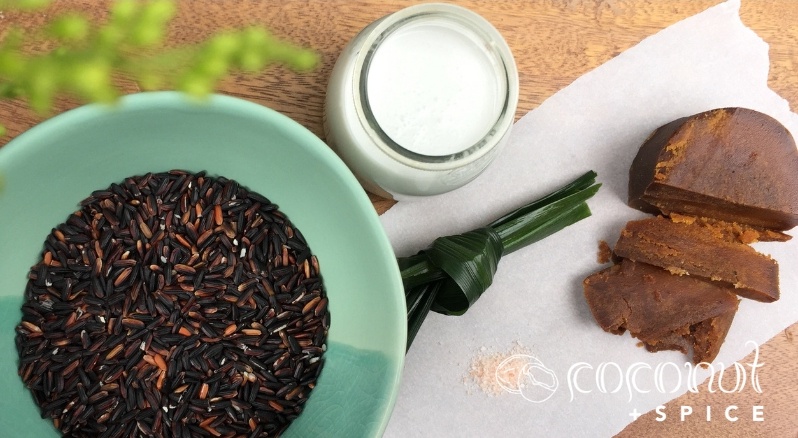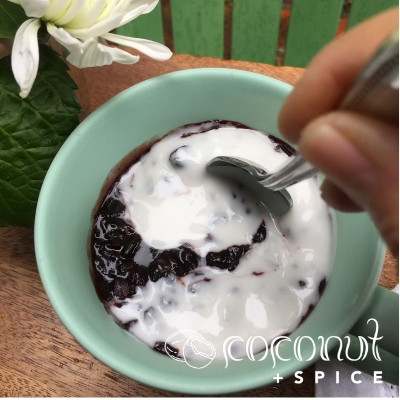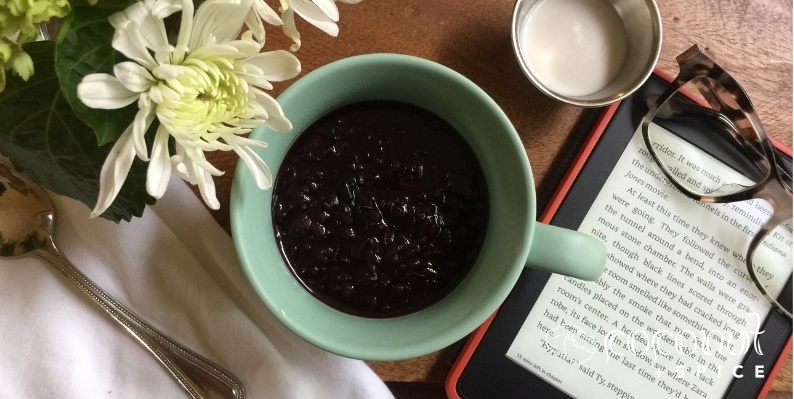Concoction of ketan hitam (black glutinous rice), pandan leaves (optional), lightly sweeten with gula jawa (Indonesian coconut palm sugar), serve with santen gurih (lightly salted coconut milk).
HOW I GOT HOOKED
I did not fall in love with
Bubur Injin, that’s how the Balinese call it, is a staple in breakfast spread of every hotel and yes, this is how I stumbled upon this delicious yet simple dish while staying at the Padma, Legian
The star of this dish is the black glutinous rice (
A CLOSER LOOK AT SOME OF THE KEY INGREDIENTS

Black Glutinous Rice
Most American have probably never heard of, let alone eaten black glutinous rice. True, it’s still quite rare
They are also called the forbidden rice because back in the days, this whole grain rice was reserved only for the Chinese Emperor and Royal family due to its nutritional value and healing abilities. Black rice is a good source of iron and vitamin E while also high in fiber
It has a natural antioxidant from the anthocyanins content (the molecules that give some plants or fruits its red, blue and purple hue such as blueberries and blackberries) and believed to have anti-inflammatory and anti-carcinogenic effects
Gula Jawa (Indonesian Coconut Palm Sugar)
This dark brown color sugar can be found in most Asian Supermarket and commonly sold in solid round/cylinder with a somewhat soft texture and can be easily shaved off or crumbled. It is used extensively in traditional Indonesian sweet snacks (check out the
For this recipe if you don’t have gula
Pandan leaves
It comes from a tropical plant that is widely cultivated in
It is used to flavor a variety of dishes, similar to how
In Asian grocery stores you may also find pandan paste sold in a small bottle which is used for flavoring and coloring in many southeast Asian desserts and sweet drinks such as

PREPARATION TIPS
- Soak glutinous black rice overnight. It will help tenderize the rice.
- In this recipe, I used Savoy brand coconut cream for a not-too-thin, not-too-thick consistency. You can use any brand of coconut cream/coconut milk available at your local grocery store. A trick to heighten the flavor of coconut milk/cream is to add a pinch of salt.
- If using pandan leaves, make a knot before dumping it in the pot.

Bubur Ketam Hitam (Black Glutinous Rice Porridge)

Concoction of ketan hitam (black glutinous rice), pandan leaves (optional), lightly sweeten with gula jawa (Indonesian coconut palm sugar), serve with santen gurih (lightly salted coconut milk).
Ingredients
For the Porridge:
- 1 cup black glutinous rice
- 5 cup water
- 3-4 tbs coconut palm sugar
- ¾ tsp salt
- 1 pandan leaves (optional)
For the Coconut Sauce:
- ½ cup coconut milk/coconut cream
- 1/8 tsp salt
Instructions
To make black glutinous rice porridge
- Place glutinous black rice in a glass bowl and add enough water to cover about 2 inches over the top of rice and soak overnight.
- Drain rice and transfer to a medium size pot, add 5 cups of water and pandan leaves if using. Place over medium heat and bring to a boil. Turn heat to low and simmer for about 1 hour and 5 minutes uncovered or until rice is very soft and most liquid has evaporated. Stir often to avoid burning.
- When rice is done, add sugar and salt and let simmer for another 5 minutes to dissolve sugar. Turn off heat.
To make coconut sauce (santen)
- Combine coconut cream and salt in a small pot and simmer until mixture is warm to the touch.
- Turn off heat.
To serve
- Serve Black Rice Porridge immediately or at room temperature, with coconut sauce on the side.
- This dish keeps well in the refrigerator. Microwave for 40-45 seconds for a nice satisfying next-day breakfast.

